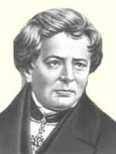The most important law of electrical engineering — Ohm's law
Ohm's Law
The German physicist Georg Ohm (1787 -1854) experimentally established that the strength of the current I flowing through a uniform metal conductor (i.e. a conductor in which external forces do not act) is proportional to the voltage U at the ends of the conductor:
I = U / R, (1)
where R — electrical resistance of the conductor.
 Equation (1) expresses Ohm's Law for a section of circuit (not containing a current source): The current in a conductor is directly proportional to the applied voltage and inversely proportional to the resistance of the conductor.
Equation (1) expresses Ohm's Law for a section of circuit (not containing a current source): The current in a conductor is directly proportional to the applied voltage and inversely proportional to the resistance of the conductor.
The section of the circuit in which the emf does not act. (external forces) is called a homogeneous section of the circuit, therefore this formulation of Ohm's law is valid for a homogeneous part of the circuit.
See here for more details: Ohm's law for a section of a circuit
Now we will consider an inhomogeneous section of the circuit, where the effective EMF of section 1 — 2 is denoted by Ε12 and applied at the ends of the section potential difference — through φ1 — φ2.
If the current flows through fixed conductors forming section 1-2, then the work A12 of all forces (external and electrostatic) done on the current carriers is the law of conservation and transformation of energy equal to the heat released in the area. The work of the forces performed when the charge Q0 moves in the section 1 — 2:
A12 = Q0E12 + Q0 (φ1 — φ2) (2)
E.m.s. E12 as well amperage I is a scalar quantity. It must be taken with either a positive or a negative sign, depending on the sign of the work done by external forces. If e.d. promotes the movement of positive charges in the selected direction (in the direction 1-2), then E12> 0. If units. prevents positive charges from moving in that direction, then E12 <0.
During the time t, heat is released in the conductor:
Q = Az2Rt = IR (It) = IRQ0 (3)
From formulas (2) and (3) we get:
IR = (φ1 — φ2) + E12 (4)
Where
I = (φ1 — φ2 + E12) / R (5)
Expression (4) or (5) is Ohm's Law for an inhomogeneous cross-section of a circuit in integral form, which is the generalized Ohm's law.
If there is no current source in a certain section of the circuit (E12 = 0), then from (5) we arrive at Ohm's law for a homogeneous section of the circuit
I = (φ1 — φ2) / R = U / R
If electrical circuit is closed, then the selected points 1 and 2 coincide, φ1 = φ2; then from (5) we obtain Ohm's Law for a closed circuit:
I = E / R,
where E is the emf acting in the circuit, R is the total resistance of the entire circuit. In general, R = r + R1, where r is the internal resistance of the current source, R1 is the resistance of the external circuit.Therefore, Ohm's law for a closed circuit will look like this:
I = E / (r + R1).
If the circuit is open, there is no current in it (I = 0), then from Ohm's law (4) we get that (φ1 — φ2) = E12, i.e. emf acting in an open circuit is equal to the potential difference across its ends. Therefore, to find the emf of a current source, it is necessary to measure the potential difference across its open-circuit terminals.
Examples of Ohm's Law calculations:
Calculation of the current according to Ohm's law
Calculating Ohm's Law Resistance
Voltage drop
See also:
On potential difference, electromotive force and voltage
Electric current in liquids and gases
Electrical resistance of wires
Magnetism and Electromagnetism
About the magnetic field, solenoids and electromagnets
Self induction and mutual induction
Electric field, electrostatic induction, capacitance and capacitors
What is alternating current and how does it differ from direct current
